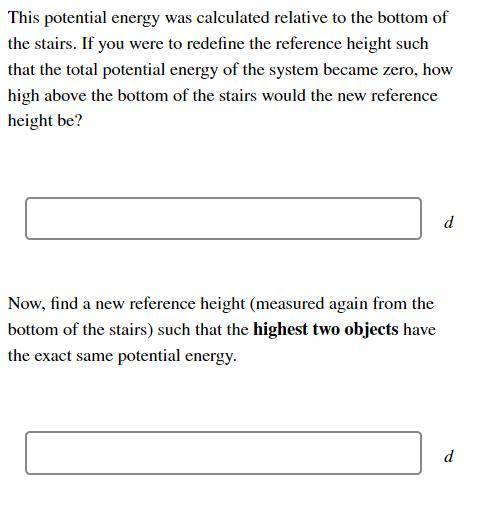
Physics, 04.02.2022 01:00 olivernolasco23
Three different objects, all with different masses, are initially at rest at the bottom of a set of steps. Each step is of uniform height . The mass of each object is a multiple of the base mass : object 1 has mass 3.10 , object 2 has mass 1.96 , and object 3 has mass . When the objects are at the bottom of the steps, define the total gravitational potential energy of the three-object system to be zero. If the objects are then relocated as shown, what is the new total potential energy of the system?
Each answer requires the numerical coefficient to an algebraic expression. Each algebraic expression is given using some combination of the variables , , and , where is the acceleration due to gravity. Enter only the numerical coefficient. (Example: If the answer is 1.23 , just enter 1.23)
This potential energy was calculated relative to the bottom of the stairs. If you were to redefine the reference height such that the total potential energy of the system became zero, how high above the bottom of the stairs would the new reference height be?
Now, find a new reference height (measured again from the bottom of the stairs) such that the highest two objects have the exact same potential energy.



Answers: 3


Another question on Physics

Physics, 21.06.2019 21:20
Which of the following explains why it took so long for the public to accept the negative health effects of smoking? a)people were waiting for counter reasons, and those were presented.b)scientists had not completely finalized their results, which took 30 years.c)cigarettes were cheaply available and media channels were very inefficient.d)cigarette manufacturers were trying hard to bring an alternative into the market
Answers: 3

Physics, 22.06.2019 11:00
Aperson walks first at a constant speed of 4.89 m/s along a straight line from point a to point b and then back along the line from b to a at a constant speed of 2.95 m/s. what is the average speed over the entire trip?
Answers: 1

Physics, 22.06.2019 12:10
Consider a one meter long horizontal pipe with a constant 100 cm^2 cross sectional area. water flows rightward into the pipe at x = 0 with flow velocity 02m/sec at every point within the pipe intake area. at x=1, the rightward flow rate is 0.192 m/sec. assume the water is a conserved quantity in the pipe, so there must be a leak (a sink) somewhere in the pipe. 1. compute net volumetric flow of the source if the system to be in equilibrium. 2. now assume the pipe in the problem has no leaks. compute the net volumetric rate of change for the system.
Answers: 3

Physics, 22.06.2019 12:50
The combining of light nuclei is called blank. blank as in not actually blank. you know what im tryin to say.
Answers: 1
You know the right answer?
Three different objects, all with different masses, are initially at rest at the bottom of a set of...
Questions

Mathematics, 11.04.2021 05:10

Mathematics, 11.04.2021 05:10

Chemistry, 11.04.2021 05:10




Mathematics, 11.04.2021 05:10



English, 11.04.2021 05:10


Mathematics, 11.04.2021 05:10


Mathematics, 11.04.2021 05:20

Mathematics, 11.04.2021 05:20





Mathematics, 11.04.2021 05:20



